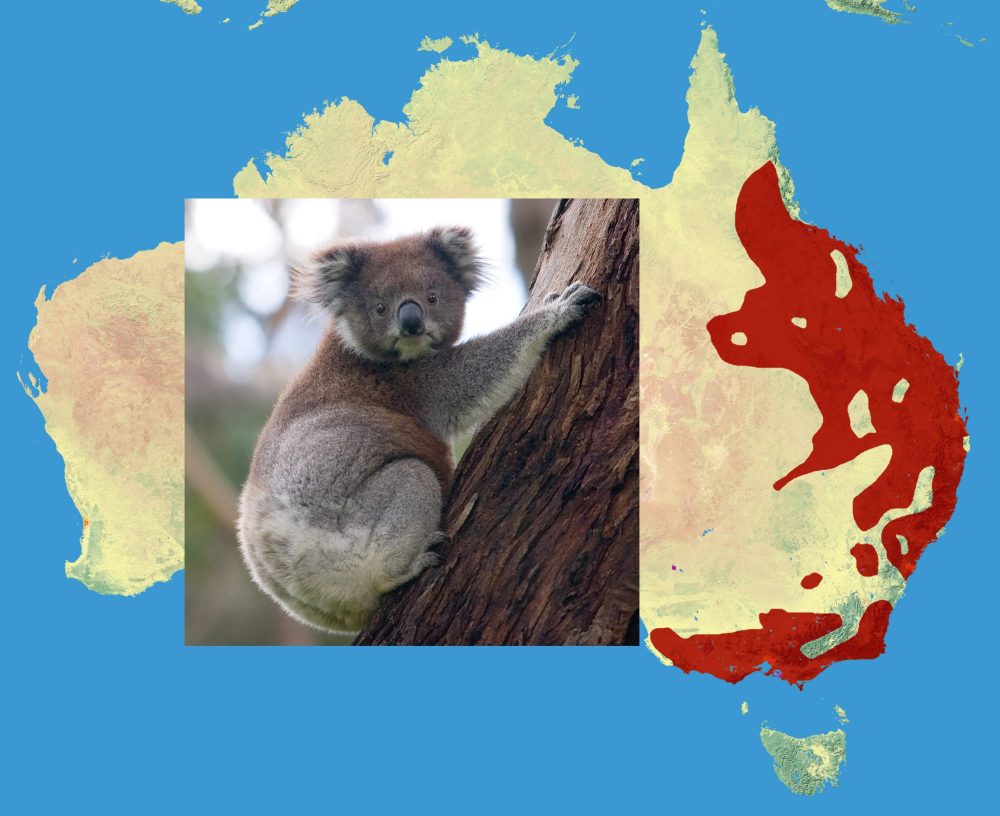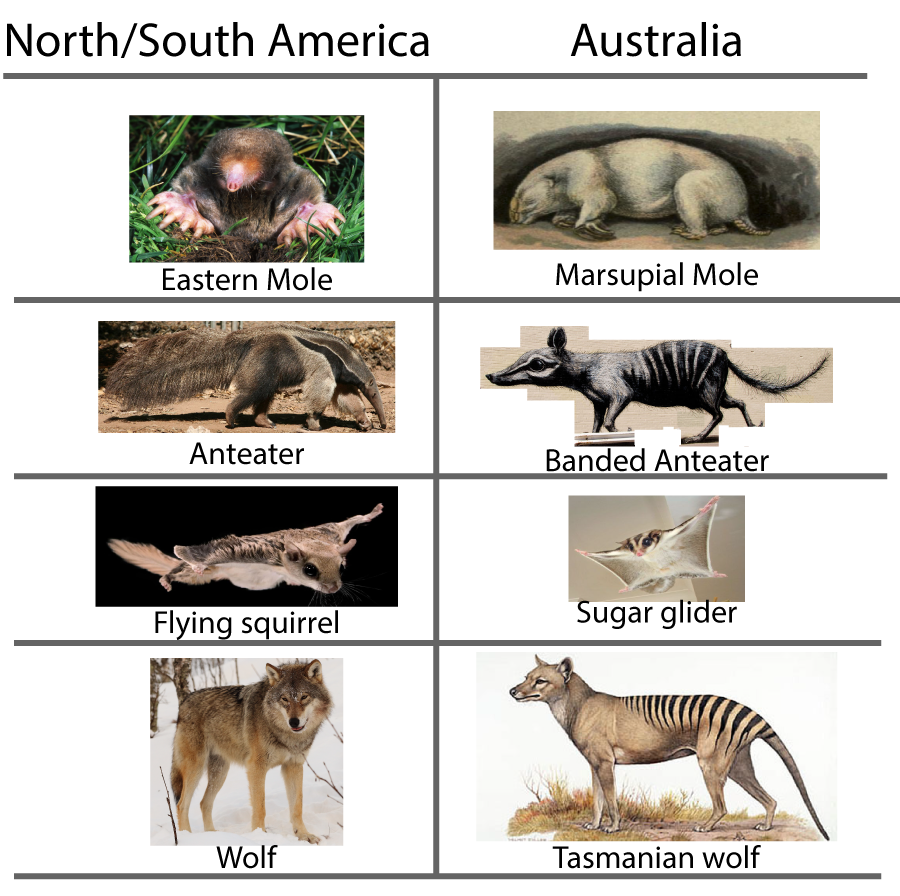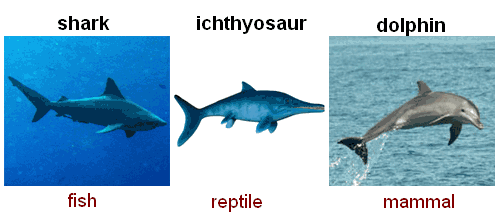1. Introduction

Biogeography is the study of the distribution of plants and animals. For example, half of the mammals in Australia are pouched mammals. Mammals with pouches are known as marsupials and include kangaroos, koalas, and wombats. By contrast, North America has only one (the Virginia opossum). Why do so many marsupials live only in and around Australia, and nowhere else? That’s a biogeographical question.
Biogeography reflects the history of how species have spread out over the Earth’s surface. Not surprisingly, biogeography also provides evidence for evolution.
2. Biogeography and Convergent Evolution
Take a look at the following plants.
[qwiz summary=”true” repeat_incorrect=”true” qrecord_id=”sciencemusicvideosMeister1961-Mystery Succulent: Introduction to Biogeography (HS)”]
[h] Mystery Succulent
[q] Plant 1
[q] Plant 2
[q] Plant 3
[q] If you (like most people in North America) had to guess what type of plants were shown in the previous slides (one of which is shown below), what would you guess? Most people guess a six-lettered plant family: [hangman]
[c]IENhY3R1cw==[Qq]
[f]IFJpZ2h0JiM4MjMwO1RoYXQmIzgyMTc7cyBpbmRlZWQgd2hhdCBtb3N0IHBlb3BsZSB3b3VsZCBndWVzcywgYnV0IHRoYXQmIzgyMTc7cyBub3QgY29ycmVjdC4gVGhlc2UgcGxhbnRzIGFyZSBhbGwgZXVwaG9yYnM=LiBFdXBob3JicyBhcmUgc3VwZXJmaWNpYWxseSBsaWtlIGNhY3RpLCBidXQg[Qq]not closely related to them. Euphorbs live in the deserts of Africa, Asia, and the driest parts of Europe. Cacti, by contrast, are mostly limited to North and South America.
[q]Study the pictures below of a cactus (left) and a euphorb) right
| Barrel Cactus, Arizona, USA | Euphorbia grandialata, Canary Islands, Spain |
Read below to see how this relates to evolution.
[q labels=”top”]Cacti and euphorbs are both ___________ to living in deserts. To avoid __________ loss, their ___________ have become reduced to spines. Their ________ are thick, coated with wax, and adapted for water_________.
[l]leaves
[fx] No. Please try again.
[f*] Excellent!
[l]adapted
[fx] No. Please try again.
[f*] Good!
[l]stems
[fx] No, that’s not correct. Please try again.
[f*] Good!
[l]storage
[fx] No, that’s not correct. Please try again.
[f*] Great!
[l]water
[fx] No, that’s not correct. Please try again.
[f*] Good!
[q labels=”top”]But cacti and euphorbs evolved these adaptations separately. In other words, as plant species go, they’re not closely ____________ to one another. They did not inherit their adaptations from a common _______________.
[l]ancestor
[fx] No, that’s not correct. Please try again.
[f*] Correct!
[l]related
[fx] No. Please try again.
[f*] Good!
[q labels = “top”]To converge, means to come together, as in “lines converging.” __________________ evolution is the process by which similar selective pressures act upon _____________ related lineages, resulting in _______________ similar _______________ in the descendants.
[l]adaptations
[fx] No. Please try again.
[f*] Excellent!
[l]Convergent
[fx] No. Please try again.
[f*] Good!
[l]distantly
[fx] No. Please try again.
[f*] Good!
[l]superficially
[fx] No. Please try again.
[f*] Excellent!
[x]Read on to see how convergent evolution supports evolutionary theory.
[/qwiz]
Why do distant areas with similar climates support unrelated species that, like cacti and euphorbs, have similar adaptations? Because of descent with modification. Over the course of evolution, one lineage of plants became adapted to the deserts of North and South America. This lineage gave rise to the cacti. Another lineage became adapted to the deserts of Eurasia, Africa, and Australia. This lineage gave rise to the euphorbs. If you look superficially, they’re similar. But a deeper look (one that includes, for example, looking at their DNA), reveals that these species aren’t closely related.
You can think of convergent evolution as being the counterpart of adaptive radiation. In adaptive radiation, one ancestral species diverges into several descendant species, each with distinct adaptations. In convergent evolution, unrelated lineages converge into superficially similar forms.
An example of convergent evolution occurring in an entire group of animals involves the marsupial mammals of Australia and the placental mammals of North and South America. As stated above, marsupial mammals have pouches where they carry their young. Placental mammals are like us: the fetus develops inside a uterus, supported by a placenta.
Study the pairs of animals in the diagram below.

Again, the key point is that the similarity is superficial. The marsupial sugar glider and the flying squirrel have evolved similar adaptations, enabling both of them to glide long distances. But in terms of evolution, these two species are distantly related. Similar natural selection upon their ancestors led each of these species to independently converge upon a gliding form.
3. Flashcards: Convergent Evolution
[qdeck qrecord_id=”sciencemusicvideosMeister1961-Convergent Evolution (HS)”]
[h]Flashcards: Convergent Evolution
[q]Define biogeography
[a]The study of the distribution of plants and animals.
[q]What’s a biogeographical question related to koala bears (or marsupials in general)
[a]A biogeographical question might be “Why are marsupial mammals so common in and around Australia, but so rare in other places?”
[q] __________________ evolution is the process by which similar selective pressures act upon _____________ related lineages, resulting in _______________ similar _______________ in the descendants.
[a] Convergent evolution is the process by which similar selective pressures act upon distantly related lineages, resulting in superficially similar adaptations in the descendants.
[/qdeck]
4. Convergent evolution leads to analogous structures
Look at the three organisms below.

An ichthyosaur is an extinct marine reptile that perished at the same time as the dinosaurs became extinct, 65 million years ago. But from its fossils, we know that it had a streamlined shape, similar to that found in sharks and dolphins. The similar form shared by all three animals is not from common ancestry. It’s an example of convergent evolution. In each group of animals, similar selective pressures resulted in similar adaptations.
The similar forms that result from convergent evolution are said to be analogous. Analogous forms or structures are superficially similar forms that result from convergent evolution.
It’s important to keep the terms analogous and homologous (and the related nouns analogy and homology) distinct. Practice their definitions.
[qdeck qrecord_id=”sciencemusicvideosMeister1961-Analogy vs. Homology (HS)”]
[h]Analogy vs. Homology: Flashcards
[q]What are analogous forms or structures?
[a]Analogous forms or structures are superficially similar forms that result from convergent evolution.
[q]What are homologous structures?
[a]Homologous structures are structures that are inherited from a common ancestor and which have evolved different functions.
[/qdeck]
Now answer the questions in the quiz below.
[qwiz qrecord_id=”sciencemusicvideosMeister1961-Homology or Analogy (HS)”]
[h] Homology or Analogy
[q multiple_choice=”true”] The wing of a butterfly and the wing of a bat.
[c]IGhvbW9sb2d5[Qq]
[f]IE5vLiBUaGVzZSB3aW5ncyBhcmUgYm90aCBhZGFwdGF0aW9ucyBmb3IgZmx5aW5nLiBCdXQgdGhleSBkaWRuJiM4MjE3O3QgcmVzdWx0IGZyb20gaW5oZXJpdGFuY2UgZnJvbSBhIGNvbW1vbiBhbmNlc3Rvci4=[Qq]
[c]IEFuYW xvZ3k=[Qq]
[f]IEV4Y2VsbGVudC4gVGhlc2Ugd2luZ3MgYXJlIHRoZSByZXN1bHQgb2YgY29udmVyZ2VudCBldm9sdXRpb24sIG5vdCBjb21tb24gYW5jZXN0cnkuIFRoZXkmIzgyMTc7cmUgYW5hbG9nb3VzIChub3QgaG9tb2xvZ291cyku[Qq]
[q multiple_choice=”true”] The beak of a platypus (a mammal) and the beak of a duck (a bird).
[c]IGhvbW9sb2d5[Qq]
[f]IE5vLiBUaGVzZSBiZWFrcyBhcmUgYm90aCBhZGFwdGF0aW9ucyBmb3IgZWF0aW5nLiBCdXQgdGhleSBkaWRuJiM4MjE3O3QgcmVzdWx0IGZyb20gaW5oZXJpdGFuY2UgZnJvbSBhIGNvbW1vbiBhbmNlc3Rvci4=[Qq]
[c]IEFuYW xvZ3k=[Qq]
[f]IE5pY2Ugam9iLiBUaGVzZSBiZWFrcyBhcmUgdGhlIHJlc3VsdCBvZiBjb252ZXJnZW50IGV2b2x1dGlvbiwgbm90IGNvbW1vbiBhbmNlc3RyeS4gVGhleSYjODIxNztyZSBhbmFsb2dvdXMgKG5vdCBob21vbG9nb3VzKS4=[Qq]
[q multiple_choice=”true”] The forearm of a human being and the flipper of a dolphin.
[c]IGhvbW 9sb2d5[Qq]
[f]IEZhYnVsb3VzLiBUaGVzZSBmb3JlYXJtcyBhcmUgYm90aCB2YXJpYXRpb25zIG9uIGEgYmFzaWMgdmVydGVicmF0ZSBmb3JlYXJtIHRoZW1lLiBUaGUgc2ltaWxhcml0eSBpbiB0aGUgdW5kZXJseWluZyBib25lcyBzaG93cyBldmlkZW5jZSBvZiBjb21tb24gYW5jZXN0cnkuIEVhY2ggZm9yZWFybSBoYXMgYmVlbiBtb2RpZmllZCBhcyBhbiBhZGFwdGF0aW9uIGZvciBhIHNwZWNpZmljIGVudmlyb25tZW50LiBUaGF0IG1ha2VzIHRoZW0gaG9tb2xvZ291cy4=[Qq]
[c]IEFuYWxvZ3k=[Qq]
[f]IE5vLiBBbmFsb2dvdXMgc3RydWN0dXJlcyByZXN1bHQgZnJvbSBjb252ZXJnZW50IGV2b2x1dGlvbi4gVGhleSYjODIxNztyZSBhbmFsb2dvdXMgaW4gdGVybXMgb2YgdGhlaXIgZnVuY3Rpb24uIEluIHRoaXMgY2FzZSwgdGhlIGZ1bmN0aW9uIG9mIHRoZSBmb3JlbGltYiBpcyBxdWl0ZSBkaWZmZXJlbnQu[Qq]
[q multiple_choice=”true”] WARNING: Think carefully! The forelimb of a bird and the forelimb of a bat are composed of similar bones. These forelimbs are
[c]IGhvbW9s b2dvdXM=[Qq]
[f]IEZhYnVsb3VzLiBJZiB5b3UgYXJlIHRoaW5raW5nIG9mIHRoZXNlIGFzIA==Zm9yZWxpbWJzIA==KGFzIG9wcG9zZWQgdG8=IGFzIHdpbmdzKQ==IHRoZW4gdGhleSYjODIxNztyZSBib3RoIHZhcmlhdGlvbnMgb24gYSBiYXNpYyB2ZXJ0ZWJyYXRlIGZvcmVhcm0gdGhlbWUuIFRoZSBzaW1pbGFyaXR5IGluIHRoZSB1bmRlcmx5aW5nIGJvbmVzIHNob3dzIGV2aWRlbmNlIG9mIGNvbW1vbiBhbmNlc3RyeS4=[Qq]
[c]IGFuYWxvZ291cw==[Qq]
[f]IE5vLiBUaGlzIGlzIHZlcnkgdHJpY2t5LiBJZiB0aGUgcXVlc3Rpb24gd2FzIGFib3V0IFdJTkdTLCB5b3UmIzgyMTc7ZCBiZSByaWdodCwgYmVjYXVzZSB0aGUgdHdvIGdyb3VwcyAoYmlyZHMgYW5kIG1hbW1hbHMpIGNvbnZlcmdlZCBvbiB0aGUgc2FtZSBzb2x1dGlvbi4gQnV0IHRoZSBxdWVzdGlvbiBpcyBhYm91dCB0aGUgZm9yZWxpbWJzLiBBcyBmb3JlbGltYnMgZ28sIHRoZXNlIHN0cnVjdHVyZXMgYXJlIGhvbW9sb2dvdXM6IHNhbWUgYm9uZXM7IHNhbWUgZW1icnlvbmljIHRpc3N1ZTsgaW5oZXJpdGVkIGZyb20gYSBjb21tb24gYW5jZXN0b3Iu[Qq]
[q multiple_choice=”true”] WARNING: Think carefully! The wing of a bird and the wing of a bat are both adaptations for flying. Both birds and bats evolved (separately) from non-flying, ground-living ancestors. The wings are
[c]IGhvbW9sb2dvdXM=[Qq]
[f]IE5vLiBJZiB5b3UgYXJlIHRoaW5raW5nIG9mIHRoZXNlIGFzIFdJTkdTLCB0aGVzZSBhcmUgbm90IHNoYXJlZCBmZWF0dXJlcyB0aGF0IHdlcmUgaW5oZXJpdGVkIGZyb20gYSBjb21tb24gYW5jZXN0b3IuIFRoZSBhbmNlc3RvcnMgb2YgYmF0cyB3ZXJlIHJvZGVudC1saWtlIG1hbW1hbHMgd2hvIGV2b2x2ZWQgaW50byBhIGZseWluZyBuaWNoZS4gVGhlIGFuY2VzdG9ycyBvZiBiaXJkcyB3ZXJlIHNtYWxsIGRpbm9zYXVycyB3aG8gc2ltaWxhcmx5IGV2b2x2ZWQgaW50byBhIGZseWluZyBuaWNoZS4gQnV0IHRoZXkgZGlkIHRoaXMgaW5kZXBlbmRlbnRseS4gVGhlIHdpbmdzIGFyZSBhbmFsb2dvdXMsIG5vdCBob21vbG9nb3Vz[Qq]
[c]IEFuYWxv Z291cw==[Qq]
[f]IFdvdyEgVGhpcyBpcyB2ZXJ5IHRyaWNreSwgYnV0IHlvdSBzdGlsbCBnb3QgaXQgcmlnaHQhIFR3byBncm91cHMgKGJpcmRzIGFuZCBtYW1tYWxzKSBjb252ZXJnZWQgb24gdGhlIHNhbWUgc29sdXRpb24uIFRoYXQgbWFrZXMgdGhlbSBhbmFsb2dvdXMgc3RydWN0dXJlcywgcmVzdWx0aW5nIGZyb20gY29udmVyZ2VudCBldm9sdXRpb24u[Qq]
[q]This diagram is saying that the streamlined form of sharks, dolphins and ichthyosaurs is an [hangman] feature. That’s because this form evolved from [hangman] evolution, and not from a common [hangman].
[c]YW5hbG9nb3Vz[Qq]
[c]Y29udmVyZ2VudA==[Qq]
[c]YW5jZXN0b3I=[Qq]
[/qwiz]
5. Biogeography, Analogies, and Convergent Evolution: Checking Understanding
[qwiz qrecord_id=”sciencemusicvideosMeister1961-Biogeography, Analogies, and Convergent Evolution (HS)”]
[h]Biogeography, Analogies, and Convergent evolution
[i]
[q]The study of the geographic distribution of species is called [hangman].
[c]YmlvZ2VvZ3JhcGh5[Qq]
[q]Species such as the euphorbs of Africa, Eurasia, and Australia and the cacti of the Americas are similar because of [hangman] evolution. Similar natural [hangman] resulted in the evolution of similar [hangman] in each group.
[c]Y29udmVyZ2VudA==[Qq]
[c]c2VsZWN0aW9u[Qq]
[c]YWRhcHRhdGlvbnM=[Qq]
[q]The marsupials of Australia and the placentals of the Americas separately evolved into similar ecological roles. While the marsupial mole of Australia and the Eastern mole of North America have similar [hangman] for a life spent burrowing through the soil, their similarity is only superficial, a result of [hangman] evolution
[c]YWRhcHRhdGlvbnM=[Qq]
[c]Y29udmVyZ2VudA==[Qq]
[q]The euphorbs of Africa, Eurasia, and Australia and the cacti of the Americas aren’t particularly closely [hangman]. Their superficially similar adaptations weren’t inherited from a common [hangman]. The best way to describe them is as [hangman] traits.
[c]cmVsYXRlZA==[Qq]
[c]YW5jZXN0b3I=[Qq]
[c]YW5hbG9nb3Vz[Qq]
[q] [hangman] traits results from shared ancestry. There is a similar underlying structure, but the [hangman] might be different.
[c]IGhvbW9sb2dvdXM=[Qq]
[c]ZnVuY3Rpb24=[Qq]
[q][hangman] traits result from convergent evolution. The function of the part might be similar, but the underlying [hangman] is usually quite different.
[c]QW5hbG9nb3Vz[Qq]
[c]c3RydWN0dXJl[Qq]
[q]REVIEW: Homologous structures, like the beaks of the Hawaiian honeycreepers shown below, evolve through [hangman] [hangman]. All of these Honeycreepers, in other words, share a common [hangman]. Over time, each species’ beak became [hangman] to a slightly different food source.
[c]YWRhcHRpdmU=[Qq]
[c]cmFkaWF0aW9u[Qq]
[c]YW5jZXN0b3I=[Qq]
[c]YWRhcHRlZA==[Qq]
[q]The beaks of the platypus and the duck are [hangman] structures that arose through [hangman] evolution.
[c]YW5hbG9nb3Vz[Qq]
[c]Y29udmVyZ2VudA==[Qq]
[/qwiz]
Links
- Developmental and Molecular Homologies (the next high school level Evidence for Evolution tutorial)
- Evidence for Evolution Main Menu
